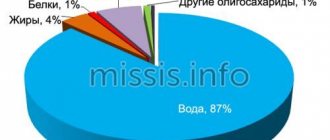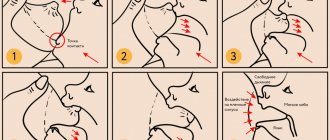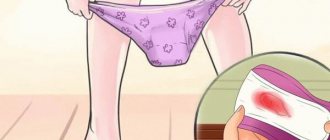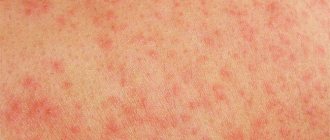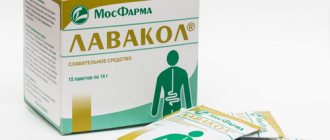There are many reasons why women may need to suppress lactation (stop milk production in the mammary glands):
- Personal reasons for not breastfeeding.
- Medical necessity to stop breastfeeding.
- Voluntary resumption of lactation after completion of the breastfeeding period.
- Permanent or prolonged separation from the child.
To stop lactation while breastfeeding, you will need to interrupt the natural reflexes that promote milk production. The easiest way is to limit the removal of milk from the breast. If milk remains in the mammary gland, the body understands that there is still a supply and will reduce the production of new milk. The fuller the breasts are with milk, the faster its production will stop.
You can express milk only if there is extreme discomfort in the chest and to prevent blockage of the milk ducts and the occurrence of mastitis.
Features of cessation of lactation immediately after childbirth
Milk production will quickly cease if the breasts are well secured and supported by a bra, and milk is expressed only to prevent significant discomfort and blockage of the milk ducts. Wearing a durable, well-fitting bra is necessary both during the day and at night. This method is more physiological and effective compared to the outdated tight breast wrap. To absorb milk, absorbent pads are placed in the cups of the bra, which are replaced as they become moisturized. If the breasts are too full, the bra is replaced by a supportive breast wrap with a strip of cotton fabric that supports but does not compress the breasts. Tight compression of the breast does not reduce milk production, but causes significant discomfort. For full engorged breast syndrome (the first week after childbirth), pain and swelling can be reduced with the help of cold compresses and wraps. You can also use a cool shower and place chilled white cabbage leaves in your bra. The leaves are pre-washed and dried, and the protruding parts are cut out of them so as not to cause chest discomfort. Leaves need to be changed every 2 hours or when they become limp. Use cabbage leaves until your breasts stop overflowing with milk. For pain, nonspecific anti-inflammatory drugs such as ibuprofen can be used.
Dos and Don'ts for Weaning
You should:
- Gradually accustom your baby to a bottle and then to a cup. If the child is older, then you can immediately switch to a cup with a sippy cup or a cup with a straw. You can give your baby expressed breast milk or formula, as well as cow's milk, starting at one year of age.
- Bottle feed your baby when he is in a good mood and not yet very hungry. In this situation, the baby may be more willing to accept the bottle. If the baby is not yet a year old, expressed milk or formula is suitable for feeding. After a year, cow's milk can be introduced.
- Use a slow flow bottle nipple at first to allow your baby to get used to bottle feeding.
- Involve someone from your family in feeding. This way, the baby will associate feeding not only with his mother, and weaning will be a little easier.
- Distract your baby when it's time to breastfeed. Give him a snack or go to the playground, visit, read to your child, or go for a walk.
- Reduce the duration of feedings
- Gradually reduce the number of breastfeedings until you manage to completely replace them with bottle or cup feeding, as well as complementary feeding if the baby is already grown.
If you started weaning between six months and one year, you should continue to give expressed breast milk or formula along with solid foods until your baby is one year old. After which it will be possible to completely switch to solid food and cow's milk.
If possible, you should not:
- Stop breastfeeding abruptly. Reduce feedings gradually, for example starting with night feedings. Reduce feedings over days, weeks or months.
- Sitting in the chair you normally feed in, or wearing the clothes you feed in, as this may send mixed messages.
- Deny the breast if the child persistently asks. This behavior can cause the baby to insist even more on breastfeeding.
- Avoid letting your child suck on his thumb or the edge of a blanket, or any other habit that helps him calm down. Perhaps this is how he copes with change, and that's normal. If you are concerned about how your baby is trying to calm himself, discuss it with your pediatrician.
Features of cessation of lactation after weeks or months of breastfeeding
If you are forced to stop breastfeeding that has already begun, measures suitable for stopping lactation immediately after birth will not be enough. A nursing mother produces about a liter of milk per day or more. In this case, it will take time to stop milk production. In this case, to prevent the occurrence of inflammatory breast diseases, you will have to gradually reduce the amount of milk expressed in order to reduce the production of hormones that cause its production. This strategy is similar to natural weaning and helps prevent the development of mastitis.
When you first stop breastfeeding, your breasts will become full. Milk will have to be expressed in volumes and on a schedule, as with breastfeeding, only gradually reducing the amount of milk expressed and increasing the pauses between expressions. You can try to do one less pumping every 3-4 days if there is no significant discomfort in the breast. After some time, there will come a point when you can express milk twice a day, and then only once a day, and finally once every few days, and stop expressing completely.
Modern aspects of lactation suppression
One of the important and responsible periods in a woman’s life is the postpartum period, the main events of which are breastfeeding the child and increasing responsibility for its development and health. The development and functional state of the mammary gland is controlled and stimulated by the body's neurohumoral system, which includes the pituitary gland, ovaries, adrenal glands, and thyroid gland. Regulation of the neurohumoral system is carried out by the hypothalamus with the help of secreted transmitters of neurohumoral signals in the body - transmitters. Transmitters, influencing the formation and release of pituitary hormones, in turn affect the activity of peripheral endocrine glands. During pregnancy, under the influence of estrogens, milk ducts are formed, and under the influence of progesterone, proliferation of the glandular tissue of the mammary gland occurs [1].
Indications for suppression of lactation
In some cases, it is necessary to reduce or completely stop lactation. Such indications may occur in the postpartum period (excessive engorgement of the mammary glands, various forms of lactation mastitis, stillbirth, severe condition of the postpartum mother, in which breastfeeding is undesirable or contraindicated), as well as after abortions, carried out mainly during long periods of pregnancy. There are absolute and relative indications for suppressing lactation.
The absolute indications for suppressing lactation are [1, 2]:
- stillbirth;
- late miscarriages;
- drug and alcohol use;
- malignant neoplasms detected during pregnancy and the postpartum period, requiring polychemotherapy and radiation therapy;
- herpetic rash on the nipples;
- active form of pulmonary tuberculosis;
- HIV infection;
- galactosemia in a child.
The following are identified as relative contraindications to breastfeeding [2]:
- severe extragenital pathology;
- infiltrative or purulent mastitis;
- anomalies of nipple development;
- pathological changes in the mammary glands (gigantomastia, mastopathy, scar changes, history of purulent mastitis, etc.);
- woman's refusal to breastfeed.
Considerable debate is raised by the issue of continuing breastfeeding and the need to suppress lactation during postpartum mastitis. With this pathological condition, functional disorders develop in the mammary gland, and then in a very short time a focus of inflammation is formed, therefore lactation mastitis is a formidable purulent-inflammatory disease of the postpartum period. Predisposing factors to the occurrence of postpartum mastitis are pathological lactostasis, cracks and abnormal development of the nipples, structural changes in the mammary glands (various forms of mastopathy, scar changes after previous purulent mastitis), decreased immunological reactivity, violation of hygiene and rules of breastfeeding [3].
There are different points of view on suppressing lactation during mastitis. In our country, the greatest contribution to the study of this issue was made by B. L. Gurtova and A. I. Emelyanova. In their opinion, feeding a sick mammary gland can cause significant harm to the child’s health and cause reinfection. It was found that with postpartum mastitis, the function of the mammary gland is disrupted, the qualitative composition of milk changes, and its contamination with pathogenic microflora increases [2, 4]. A high degree of contamination of milk with Staphylococcus aureus indicates the need to stop breastfeeding until signs of the inflammatory process disappear and until milk samples that do not contain pathogenic microflora are obtained from both mammary glands. Unavoidable contact with a sick mother during breastfeeding increases the risk of infection of the infant and can lead to severe illness in the newborn. Natural feeding of a child with a purulent form of mastitis is unacceptable, and continued lactation contributes to the progression of the inflammatory process in the mammary gland [3].
To increase the effectiveness of complex therapy for postpartum mastitis, B.L. Gurtov proposed in 1984 to inhibit or suppress lactation [3]. Inhibition of lactation is an artificial reduction in the intensity of the processes of milk formation and milk flow; suppression of lactation - complete cessation of these processes. Criteria for the differentiated prescription of bromocriptine were developed, which took into account the nature of lactation, the severity of lactostasis, and clinical signs of the disease - general and local. With infiltrative mastitis, lactation inhibition is initially resorted to; If there is no effect from complex therapy, lactation is suppressed within two to three days. With purulent mastitis, in most cases it is necessary to suppress lactation. It has been shown that inhibition of lactation in complex therapy of mastitis leads to a reduction in treatment time, a decrease in the total dose of antibiotics, which reduces the frequency and severity of side effects and complications associated with antibiotic therapy.
According to Gurtovoy B.L. (1984), the indications for suppressing lactation in postpartum mastitis are [3]:
- rapidly progressing inflammatory process - transition from the serous stage to the infiltrative stage within 1–3 days, despite active complex treatment;
- purulent mastitis with a tendency to form new lesions after surgery;
- sluggish, treatment-resistant purulent mastitis (after surgical treatment);
- phlegmonous and gangrenous mastitis;
- mastitis in the presence of severe diseases of other organs and systems.
There is another point of view on the suppression of lactation during postpartum mastitis. If the suppression of lactation during purulent mastitis (especially with the visible appearance of pus) is beyond doubt, then the opinion about the suppression or inhibition of lactation during serous and infiltrative mastitis is controversial. Foreign authors believe that continued feeding by placing a newborn on the sore mammary gland is completely harmless to him, most fully contributes to the resolution of lactostasis, and therefore the rapid cessation of the inflammatory process, and recommend stopping natural feeding of the child only when pus appears visible in the mother’s milk [8, 10 , 11, 14]. We believe that it is more advisable not to put the baby on the diseased and healthy mammary glands during purulent mastitis. Milk from a healthy mammary gland must be expressed, pasteurized and fed to the baby. Milk expressed from a diseased mammary gland is not suitable for feeding a child. Lactation must be suppressed in exceptional cases: in case of severe inflammatory process in the mammary gland (gangrenous or total phlegmonous mastitis, sepsis); in case of relapse of mastitis or at the urgent request of the mother [6].
When a nursing mother shows the first signs of an infectious disease, her baby has already been exposed to the pathogen. Stopping feeding does not prevent the child from being exposed to infectious agents, but, on the contrary, helps to reduce the protective mechanisms of the newborn’s body due to a decrease in maternal antibodies and other factors transmitted through breast milk [10].
According to some foreign researchers, bacterial infections of the mother are rarely complicated by transmission to the newborn. For example, in their opinion, postpartum women with mastitis can continue breastfeeding. In the case of abscess mastitis, in the presence of severe pain, feeding can be continued with a healthy breast [9, 11, 14]. In mothers with tuberculosis, breastfeeding can be started if the mother is not infectious or two weeks after treatment. Patients suffering from tuberculosis can combine feeding with taking anti-tuberculosis drugs, since most of them do not have a negative effect on newborns [7, 12, 13]. It should be remembered that when treating with isoniazid, it is necessary to prescribe pyridoxine to the child [8].
In case of parasitic diseases of the mother, for example, malaria, breastfeeding continues depending on the clinical picture of the disease in the woman. Antimalarial drugs, which include chloroquine, hydroxychloroquine, quinine, are compatible with breastfeeding, since their content in milk does not exceed the permissible limit. If a child has a deficiency of glucose-6-phosphate dehydrogenase, taking quinine is contraindicated [7, 13].
In case of a fungal infection in the mother, for example, with vulvovaginal candidiasis in the postpartum period, breastfeeding does not stop, including when treated with local or systemic antimycotics, for example, fluconazole [9, 13].
For most viral infections, breastfeeding is not contraindicated. Transmission of the virus through milk during HIV infection in the mother has been proven, therefore breastfeeding is contraindicated [9, 11, 12]. Breastfeeding is also not recommended if the mother is infected with T-lymphotropic viruses types 1 and 2 [9, 12]. With latent cytomegalovirus (CMV) infection, reactivation of the virus in milk and infection of the child is possible. However, maternal antibodies that have passed through the placenta circulate in the blood of newborns, so they are protected from severe disease. The issue of breastfeeding premature infants, especially those born before 32 weeks of gestation, by CMV-positive mothers is controversial [10, 11, 15, 17].
Recommendations for breastfeeding in relation to each type of antimicrobial therapy have been summarized and published by the Canadian Pediatric Society and presented in
Methods for suppressing lactation
Various pharmacological and non-pharmacological methods are used to suppress lactation. Despite the large number of articles and studies on this issue, there are still no universal guidelines for suppressing lactation in the postpartum period.
Many methods of suppressing lactation are not effective enough and are currently of mainly historical interest. These include significant restriction of fluid intake, tight bandaging, prescription of saline laxatives, diuretics, and camphor preparations.
Gurtovoy B.L. (1984) recommended the combined use of estrogens and androgens: 1 ml of a 0.1% oil solution of estradiol dipropionate and 0.5 ml of a 5% oil solution of testosterone propionate are administered intramuscularly in one syringe 1 time per day or every other day in a course of 6–12 injections [3]. However, this type of treatment was not very effective, as it was associated with an increased risk of thromboembolic complications.
The most appropriate and rational method of inhibiting lactation is the use of prolactin inhibitors, which are agonists of dopamine D2 receptors (stimulating the production of the prolactin-inhibiting factor in the hypothalamus - 2-bromo-alpha-ergocryptine (bromocriptine) [4, 5]. The drug has an active effect on the circulation of dopamine and norepinephrine in the central nervous system, reduces the release of serotonin. Due to the stimulating effect on dopamine receptors of the hypothalamus, bromocriptine has a characteristic inhibitory effect on the secretion of hormones of the anterior pituitary gland, especially prolactin and somatotropin. Endogenous dopamine is a physiological inhibitor of the secretion of these hormones. In
The recommended scheme for suppressing lactation in case of mastitis is given [4].
To prevent the onset of lactation, the drug should be taken as soon as possible after childbirth or abortion, but not earlier than 4 hours. 2-3 days after discontinuation of the drug, slight secretion of milk sometimes occurs. In order to reduce physiological lactation when breast engorgement occurs in the postpartum period, bromocriptine is prescribed as a single dose of 2.5 mg. If necessary, after 6–12 hours, the same dose of the drug is re-prescribed on an empty stomach.
The Pharmacological State Committee of the Russian Ministry of Health recommended the use of bromocriptine to suppress lactation only in severe septic mastitis due to the possible development of serious complications such as pulmonary embolism, stroke, decreased visual acuity and others, including death (“Drug Safety”, Bulletin No. 1 , 1998; bulletin No. 1, 2000) [6]. Between 1980 and 1994 There were 531 reports of adverse reactions following the use of bromocriptine in women aged 15–40 years, including 32 deaths due to stroke, myocardial infarction and hypertension. However, it is not entirely certain that these severe complications are due only to the use of therapeutic doses of this drug. When using bromocriptine, other side effects are also possible: nausea, vomiting, dizziness, headache, drowsiness, psychomotor agitation, allergic reactions, cramps in the calf muscles.
Our experience with the use of bromocriptine since 1980 to suppress lactation after childbirth has shown the absence of serious complications when taking the drug. At the beginning of bromocriptine therapy, nausea, vomiting, dizziness, and fatigue may occur, which do not require discontinuation of the drug. Rarely, orthostatic hypotension may occur.
The use of bromocriptine is contraindicated in severe forms of cardiovascular disease, uncontrolled arterial hypertension, and hypersensitivity to ergot alkaloids. It is necessary to regularly monitor blood pressure (BP), especially in the first week of therapy. In case of development of arterial hypertension, especially when severe headaches occur, the drug is discontinued and an appropriate examination is immediately carried out.
When lactation is suppressed, the mammary gland is carefully expressed immediately after taking the first dose of the drug, with a mandatory subsequent reduction in the volume and frequency of expression. This is required due to the fact that, on the one hand, a sudden cessation of expressing the mammary gland during mastitis can cause a relapse of lactostasis, and on the other hand, expressing milk increases the secretion of prolactin and further milk production [6].
In recent years, the attention of clinicians has been attracted by a new synthetic drug from the ergoline group - cabergoline, produced in 0.5 mg tablets [5]. It is a potent inhibitor of prolactin secretion with long-lasting action. Carbegoline stimulates dopamine D2 receptors of lactotropic cells of the pituitary gland and reduces the level of prolactin in the blood, which is observed 3 hours after taking the drug and lasts up to 14–21 days when postpartum lactation is suppressed.
Indications, contraindications for the use of cabergoline and side effects are similar to bromocriptine. However, side effects of cabergoline are observed significantly less frequently and are of moderate severity. According to comparative studies, a single dose of 1 mg of cabergoline is as effective in preventing postpartum lactation as taking bromocriptine 2.5 mg 2 times a day for 14 days. In women treated with cabergoline, the incidence of rebound reaction in the third week after birth was significantly lower compared to bromocriptine. To prevent postpartum lactation, the drug cabergoline is prescribed 1 mg once on the first day after birth. To suppress lactation that has already begun - 0.25 mg (1/2 tablet) every 12 hours for two days.
Among the side effects that may be observed when using cabergoline are nausea, vomiting, headache, general weakness, abdominal pain, constipation, decreased blood pressure, psychomotor agitation, and cramps in the calf muscles. Extremely rare side effects when taking the drug are impaired consciousness, psychosis and hallucinations. This drug should not be prescribed for postpartum psychosis or a history of it and postpartum hypertension and with caution - for cardiovascular diseases, Raynaud's syndrome, renal or liver failure, gastric ulcer, duodenal ulcer, gastrointestinal bleeding. Therefore, when prescribing carbegoline, monitoring of blood pressure and gastrointestinal tract functions is necessary. If blood pressure increases, persistent headaches occur, or any signs of neurotoxicity occur, the drug should be discontinued. It is important to remember that the simultaneous use of carbegoline with antibiotics from the macrolide group increases the risk of side effects.
In 2009, a systematic review from the Cochrane database analyzed the results of randomized trials of the effectiveness of methods used to suppress lactation in the postpartum period. The meta-analysis included 46 studies (5164 women), of which 5 studies (206 women) found bromocriptine to be effective in suppressing lactation compared with no treatment for 7 days postpartum, of which three studies included 107 women. , relative risk (RR) was 0.36 (95% confidence interval 0.24–0.54). When comparing bromocriptine with other pharmacological agents, there were no significant differences in their effectiveness (RR - 0.79, 95% confidence interval 0.54–1.17). Side effects were negligible; 4 studies did not report a single case of thromboembolism [16].
Thus, in recent years there has been a tendency towards a reduction in indications for suppressing lactation in various infectious diseases in the postpartum period. Breastfeeding during postpartum mastitis remains a controversial issue. We believe that in severe forms of postpartum mastitis (long-term infiltrative, purulent) inhibition and, in some cases, suppression of lactation is necessary. Assessing the comparative effectiveness of various drugs to suppress lactation requires further research.
Literature
- Obstetrics: national guide / ed. E. K. Ailamazyan, V. I. Kulakov, V. E. Radzinsky, G. M. Savelyeva. M.: GEOTAR-Media, 2009. 1200 p.
- Gurtova B. L., Emelyanova A. I., Voropaeva S. D. Postpartum mastitis. Scientific and practical results on diagnosis and treatment // Obstetrics and gynecology. 2008. No. 5. pp. 15–18.
- Gurtovoy B.L., Emelyanova A.I., Ryabenko L.V. et al. The use of Parlodel for postpartum mastitis // Obstetrics and Gynecology. 1984. No. 5. pp. 22–25.
- Gurtovoy B. L., Kulakov V. I., Voropaeva S. D. Use of antibiotics in obstetrics and gynecology. M., 2004.
- Pustotina O. A., Pavlyutenkova Yu. A. Lactation mastitis and lactostasis // Russian Bulletin of Obstetrician-Gynecologist. 2007. No. 2. P. 55–58.
- Chadayev A.P., Zverev A.A. Acute purulent mastitis. M., 2003.
- American Academy of Pediatrics, Committee on Drugs. The transfer of drugs and other chemicals into breast milk // Pediatrics. 2001; 108:776–789.
- American Academy of Pediatrics. Perinatal Infections. In: Gilstrap L.C., Oh W., eds. Guidelines for Perinatal Care, 5th edn. Illinois: American Academy of Pediatrics, 2002: 285–329.
- American Academy of Pediatrics. Transmission of infectious agents via human milk. In: Pickering LK, ed. Red Book: 2003 Report of the Committee on Infectious Diseases, 26th edn. Illinois: American Academy of Pediatrics, 2003: 118–121.
- Canadian Pediatric Society // Maternal infectious diseases, antimicrobial therapy or immunizations: very few contraindications to breastfeeding // Can J Infect Dis Med Microbiol. 2006, September/October. Vol. 17. No. 5. P. 270–272.
- Lamounier JA, Moulin ZS, Xavier CC [Recommendations for breastfeeding during maternal infections] // J Pediatr (Rio J). 2004; 80(Suppl):S181–188.
- Lawrence RM, Lawrence RA Breast milk and infection // Clin Perinatol. 2004; 31:501–528.
- Mathew JL Effect of maternal antibiotics on breast feeding infants // Postgrad Med J. 2004; 80: 196–200.
- Michie C., Lockie F., Lynn W. The challenge of mastitis // Arch Dis Child. 2003; 88:818–821.
- Miron D., Brosilow S., Felszer K. et al. Incidence and clinical manifestations of breast milk-acquired Cytomegalovirus infection in low birth weight infants // J Perinatol. 2005; 25: 299–303.
- Oladapo OT, Fawole B. Treatments for suppression of lactation // Cochrane Database Syst. Rev. 2009, Jan 21(1):CD005937.
- Schanler RJ CMV acquisition in premature infants fed human milk: Reason to worry? // J Perinatol. 2005; 25: 297–298.
Key words: breastfeeding, mammary gland, transmitters, suppression of lactation, engorgement of the mammary glands, lactation mastitis, lactostasis, bromocriptine, cabergoline.
R. G. Shmakov, Doctor of Medical Sciences A. I. Emelyanova , Doctor of Medical Sciences E. S. Polushkina Federal State Institution “Scientific Center of Obstetrics, Gynecology and Perinatology named after. V. I. Kulakova" Rosmedtekhnologii, Moscow
How to quickly stop lactation?
The speed of cessation of lactation depends on a number of factors:
- The baby's age and the amount of milk produced.
- Stage of pregnancy when it is terminated (lactation is possible after termination of pregnancy after the 18th week).
- The amount of milk expressed, milk flowing out.
- Pressure on the nipples (during work, sports, sex).
- Presence of next pregnancy.
Some mothers take weeks to stop breastfeeding. For others, the process takes only a few days. However, milk stains on your bra can sometimes be noticed several months or even years after you think that lactation has stopped: for each mother, the process of stopping lactation occurs individually.
Be prepared for leaks!
Even after the cessation of lactation or in its last stages, unexpected copious discharge of milk from the breast is possible. This can happen when hugging a partner, when having sex with him, when being sexually aroused, when thinking about a child, when touching the breast. To prevent unexpected milk leaks, wear absorbent pads in your bra. Keep a spare supply of such gaskets with you. Wear dark-colored tops so that milk stains are not as noticeable. Take a spare set of clothes with you, especially for more important occasions.
Express some milk before leaving the house. If you feel milk leaking, cross your arms over your chest to stop the flow.
In all cases, get advice from a breastfeeding specialist on how best to stop lactation in your case.
When to start weaning
Breastfeeding is recommended during the first year of a baby's life, with the introduction of complementary foods starting from the sixth month. Therefore, some mothers gradually stop breastfeeding when the baby turns one year old. Some do it earlier, some later, and some mothers wait until the baby is ready to stop breastfeeding.
When to stop breastfeeding is a personal choice. Sometimes the mother may be forced to stop feeding, for example due to returning to work. Painful sensations or cracks in the nipples can trigger the end of breastfeeding.
It is worth noting that for some children, weaning at an older age (for toddlers) may be more difficult. For example, weaning a two-year-old toddler from breastfeeding may be more difficult than a baby under one year old, due to a strong habit.
However, in theory everything is simpler, in practice it can be more complicated. Try not to compare your personal circumstances to those of other moms and don't be pressured into choosing a specific time. Instead, focus on what feels right for you and your baby, and consult with your pediatrician.
Remember that even if you wean your baby off the breast, you can continue to provide all the nutrients he needs by giving him breast milk in a bottle or cup, formula, and complementary foods (depending on age).
Call a breastfeeding specialist to your home
At the Group’s children’s medical centers, we know that the most convenient place for breastfeeding consultations is your own cozy home:
- A specialist will come to you at a convenient time. You don't have to go to the clinic and wait in line. Consultations can also be held directly in the maternity hospital (if visits are permissible) or in a medical center.
- A familiar home environment makes consultation easier for both mother and child.
- At home, the consultant will be able to devote more time to both the child and the parents.
- The consultant is always a phone call away: day and night (at night you can call the contact center or write to the consultant, the consultant will answer as soon as possible), on weekdays and on weekends.
- Support from a specialist is not one-time consultations, but accompaniment: the consultant will visit the mother and baby again, if necessary, after 2-4 weeks to check how feeding is going and the baby’s weight gain.
In addition to calling a breastfeeding specialist to your home, you can call doctors of the main specialties: pediatrician, surgeon, allergist, urologist, pulmonologist, hematologist, dermatologist, ophthalmologist, ENT doctor, orthopedist, gastroenterologist and osteopath. You can also take tests, perform physiotherapy and massage at home. Infant swimming consultants can advise you at home and conduct a master class.
Find out about the special offer “Comprehensive examination at home”: the convenience of this program is that you can choose from a list of pediatric doctors exactly those specialists that your child needs and an individual set of medical services with a 20% discount!
Basics of treatment with drugs that suppress lactation
The prescription of drugs that suppress lactation, as well as individual regimens for their use in each patient, is carried out exclusively by a doctor.
All drugs that suppress lactation differ in the speed of onset of their main effect. Thus, the pronounced effect of bromocriptine develops after 14 days, cabergoline - after 3 hours, quinagolide - after 4-6 hours. The duration of action of lactation suppressants also varies: the effect of bromocriptine lasts 8-12 hours, quinagolide - about 24 hours, cabergoline - 7-28 days. This determines the dosage regimen of the drug and the duration of treatment.
The course of treatment with bromocriptine is usually at least two weeks. Cabergoline is prescribed once to suppress physiological lactation; For the treatment of hyperprolactinemia, a long course is used, prescribing the drug 1 or 2 times a week. Quinagolide is used for at least one month.
Advantages of calling Virilis Group specialists to your home
- Travel to any area of the city and region without restrictions.
- No insurance, registration or citizenship is required to receive medical care.
- Providing assistance to children of any age.
- Experience in responsible treatment of children in St. Petersburg since 1991.
- 6 own children's medical centers with 650 specialists in 49 specialties.
- Possibility of diagnostics and continuation of treatment in our clinics.
- Coordination with other doctors of the VIRILIS Group of Companies clinics: we are a single team, and not individual doctors from a “mobile” clinic.
- 24/7 contact center.
- Issuance of official medical certificates and documents.
- Possibility of purchasing a package of a comprehensive medical program for a child, including the “Emergency Care” and “Comprehensive Examination at Home” packages.
- Special medical programs for newborns and infants.

